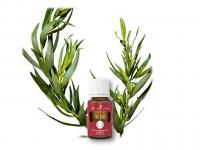November 12, 2017
Throughout history, tea tree oil has been used for many therapeutic and medicinal purposes. According to belief of the Aboriginal people of Australia, tea tree oil has amazing magical healing powers. There is even a tribal legend about the hidden treasure of the tea tree, which is described as an enchanted lagoon where the leaves of the tree were soaked after falling in, infusing and enriching the waters. In order to get all physical and mystical benefits that the waters possessed, the village people should immerse themselves in the natural herbal bath. When the Australian Aboriginal people have long recognized tea tree as multi-faceted healing oil, the rest of the world thought it was just a weed. For a long time Aboriginal tribesmen used tea tree to cure infected wounds and reduce poisons in the system (especially those given by spider bites), tea tree was only recognized by Western cultures in the early 1900s.
In 18th century when British sailors landed on the southeast shores of Australia, they discovered massive groves of trees thick with sticky, aromatic leaves. The leaves of these trees, which was later named the Melaleuca alternifolia (tea tree), had been used for many years to treat cuts and wounds. Tea tree oil is derived from the Melaleuca alternifolia plant, which is native to southeast Queensland and New South Wales in Australia; it has been widely used in Australia for many decades as a treatment for viruses, bacteria, and fungi. Today the popularity of tea tree oil has increased due to its well- known benefits, including its powerful antiseptic properties and healing ability. It is widely used in a range of products throughout the pharmaceutical, therapeutic, cosmetic, veterinary, industrial, and household product industries.
Melaleuca alternafolia (Tea Tree) is a small tree similar to cypress. It grows to about 20 feet and is now cultivated in plantations though its original home was in marshy areas.
Tea trees have great vitality and can continue to flourish even when chopped down and is ready for cutting again in two years. The best oils are produced in Australia. The oil is obtained by steam distillation.
Tea tree is most importantly used to help the immune system fighting off infection. It activates the white corpuscles to aid in the defense against invading bacteria and helps to shorten the duration of an illness. It has properties that are antibiotic (combats infection) antiseptic (helping to control infection), a bactericide (kills bacteria), and fungicide (kills fungus). It was found that tea tree lends a note of revitalization especially after a shock.
All these amazing properties make tea tree oil especially useful for acne, athletes' foot, cold sores, ringworm, would healing insect bites and stings, colds and flu and thrush (yeast infections).
Tea tree blends with several essential oils very well. Lemon adds an uplifting scent and will bolster its antiseptic properties. These two oils together make a great pre-op massage product. Just blend 10 drops total (for example six of tea tree and four of lemon) per ounce of massage oil. Putting one drop of each essential oil lemon and tea tree per ounce of water makes a great antiseptic room spray. This spray is perfect for hospital or sick rooms to disinfect. Just shake the bottle each time before use and spray, allow sitting on the surface for a few seconds before wiping the surface with a clean towel; giving a room a lovely uplifting scent. Cypress lends a woody feel to tea tree and is good to use for those with athletes foot. Place six drops total cypress and tea tree combined into a spray bottle filled with a 50/50 mixture of distilled water and 70 percent alcohol. Shake before each use and spray on feet. Allow the mist to dry, and experience relief from this troubling problem. This spray can also be used in sneakers and other shoes as a gentle disinfectant.
Tea tree's reputation as a remedy for acne is well known and very, very popular. Tea tree can help to kill bacteria and acts as an anti-inflammatory even in the severe cases of acne.
In a dark glass bottle you can blend equal drops of pure essential oil of tea tree and…
Sage (Salvia officinalis) – for hormonal type acne;
Lavender (Lavendula officinalis) – for redness
and inflammation;
Grapefruit (Citrus paradise) – for blackheads to enhance desquamation of surface cells;
Cedarwood (Cedrus atlantica) – for over active oil glands.
Use your blends in the following ways:
Place one drop per ounce of distilled water into a spray bottle. Shake before each use and use as a gentle toner. Close eyes before spraying the face.
Place two drops in a clay mask, stir well and use as a finishing mask during facial therapy.
Use two to four drops per ounce of a neutral gel cleanser.
Use four drops per ounce in massage oil such as jojoba for a light facial massage.
Remember – pure essential oils are the very concentrated essence of plants. Do not use them on the skin neat (plain) as they can cause irritation especially when the skin is already inflamed. It is best to always use a medium of dispersion (water, lotion, oil, masks, et cetera) to dilute the essential oil which enhances its effectiveness. Do not place essential oil on or in the eyes and do not ingest. Enjoy exploring tea tree and other essential oils to promote your health and well-being.
Source: Victoria Tabak, “The Natural Wonders of Tea Tree Oil,” Dermascope, November 1, 2017
This article is for informational purposes only. It is not intended to treat, diagnose, cure, or prevent disease. This article has not been reviewed by the FDA. Always consult with your primary care physician or naturopathic doctor before making any significant changes to your health and wellness routine.

